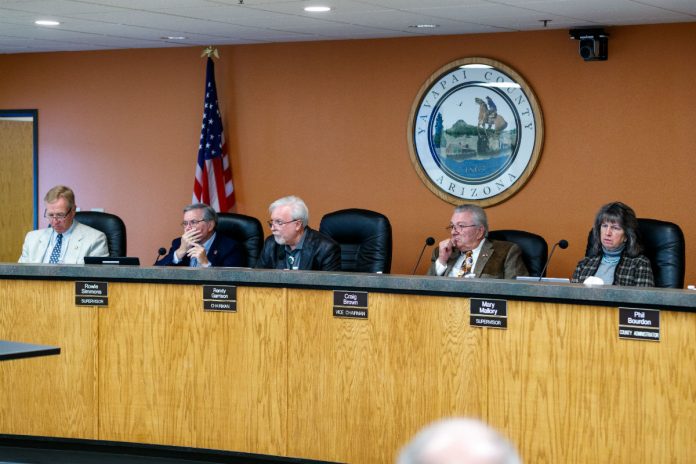It was another unanimous vote by Yavapai County officials.
On Wednesday, Nov. 20, the Yavapai County Board of Supervisors voted 5-0 to approve a zone map change for a proposed 154-room Hilton Garden Inn at the intersection of Jacks Canyon Road and State Route 179 in the Village of Oak Creek.
The decision comes on the heels of the Yavapai County Planning and Zoning Commission’s 10-0 vote on June 20 in favor of recommending a zone change approval to the supervisors.
Prior to the vote, District 2 Supervisor Tom Thurman said even if Chandrika and Jack Patel’s request for a zone change was granted, there are still several steps ahead of them, including the building permit process and Arizona Department of Transportation approval. This means there will be additional opportunities for public input before the hotel is approved.
“The traffic study has to work with ADOT, as do things with our public works department and the fire department,” he said. “They have a lot of hurdles — including flood control district — to get over and any one of them could kill it.”
Thurman added that under the new zoning this project could easily be turned into a gas station, mini mart, a grocery story or more retail. That’s something he wouldn’t want to see because those would result in even more traffic than would a hotel. In fact, Patel attorney Jennifer Boblick said the hotel would generate an average of 1,261 daily trips [entering and existing] compared to a grocery store’s 4,000 daily trips.
As part of the recommendation to approve, the planning and zoning commission added several stipulations, which were part of the supervisor’s vote. Some of these included that if a hotel is built, the maximum height shall be 34 feet measured from the natural grade, including the parapets. The maximum height for the elevator, stairwell and shade structures will be 44 feet. If something other than a hotel is built on the property, the maximum height will be 30 feet, even if the property is sold.
Moreover, a building permit application must be submitted within five years of approval of the supervisors or the requested zoning of C2-1 [commercial, general sales and services] will revert back to the current zoning of RCU-2A [residential, rural, two-acre minimum lots] — a common provision for zone change requests. The RCU- 2A zoning has been in place since 1968. The Patels have owned the land since 1992.
“This property, based on the other conditions and uses of those properties up and down this corridor, is commercial,” District 3 Supervisor and Board Chairman Randy Garrison said. “To expect anything less on this property is not realistic.”
He added, “I understand if you’re not happy about this. Growth is here. Tourism is here. It’s unfortunately the product of where we’ve gone and what we’ve become but it’s here. With this corridor, if you think this is the last time you’re going to see development, you’re wrong.”
County officials received more than 1,500 letters, emails and signatures in opposition to the project — most of which came from the VOC. Those opposed to the project expressed many of the same concerns they had in June. Garrison read more than 50 names of those who were opposed and wished not to speak followed by more than 20 of those who took the podium to express their opposition.
Some of the concerns included the proposed hotel being too big, traffic congestion, too many hotels already in the area, wildfire evacuation concerns at the intersection, impact on the quality of life, decreased property values, increased emergency service response time, lack of housing for employees and impacted viewshed.
Another concern was that when the Patels purchased the land they agreed to the covenants, conditions and restrictions set forth by the Village of Oakcreek Association. The county cannot take CC&Rs into consideration but it was pointed out that VOCA could take legal action against the Patels if the organization feels the CC&Rs have been violated.
During the June planning and zoning meeting, Commissioner Mark Mumaw, one of two commissioners who represent District 3, which includes the VOC, said that he’s known for years that the property in question would eventually be rezoned commercial, as are most parcels along the State Route 179 corridor through the Village. He said that with the added stipulations, it gives the county some control over what could be built under C2-1 zoning.
“This should not be a surprise to anybody,” Mumaw said in terms of a rezoning request. “It’s unfortunate that if the community wanted to do something different with it that it didn’t take some course of action like incorporation or find a way to purchase the property and turn it into something else, but they didn’t do that.”
Mumaw went on to say that he’s extremely concerned that if the county were to deny this request, it could be sued by the Patels under Proposition 207. And based on past cases, he said none of the stipulations would have to be honored — including height nor the agreed-upon setbacks — if the court ruled against the county.
“Then you’re looking at any C2-1 zoning at 50 feet high with 10-foot to 20- foot setbacks,” he said. “I, personally, am not willing to take that kind of risk for my community. With the stipulations, this is something I can live with. This could be far, far, far worse.”






















